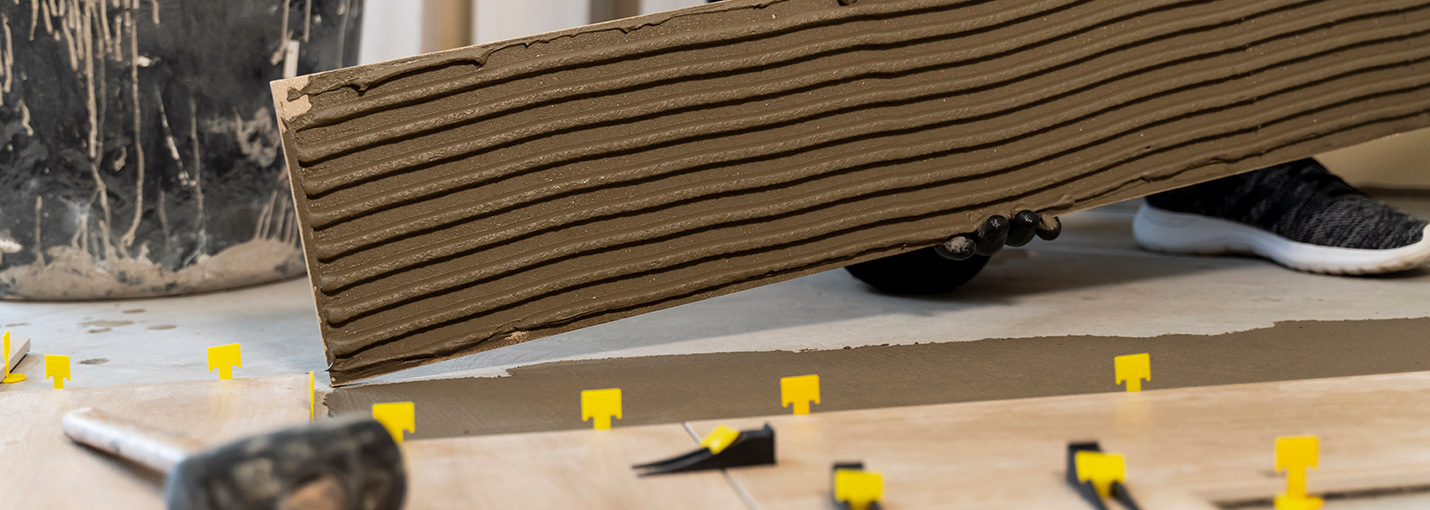Asbestos is a naturally occurring mineral that is known for its heat resistance and durability. It was once extensively used in construction materials such as floor tiles. Though the benefits were recognized, the detrimental health effects have led to widespread concerns.
!
Si cree que estuvo expuesto al asbesto, incluso cuando era niño, hable con un proveedor de atención médica sobre pruebas y exámenes para ayudar a diagnosticar cicatrices pulmonares y detectar enfermedades relacionadas con enfermedades relacionadas con el asbesto.
Asbestos-containing floor tiles, if not managed properly, can pose serious health and legal risks.
This guide will explore the best way to seal asbestos tiles. Meanwhile, we’ll be taking into consideration the need for sealing, the prevalence of asbestos in buildings, health dangers, legal implications, and the advantages of selling asbestos-free spaces.
With that in mind, let’s take a closer look at everything you need to know about asbestos and the best way to seal tiles that contain it.
The Need to Seal Asbestos Tiles
The primary reason for sealing asbestos tiles is to prevent the release of harmful asbestos fibers into the air. Asbestos-containing materials, when damaged or disturbed, can release tiny fibers that, if inhaled, can lead to respiratory issues, including lung cancer, asbestosis, and mesothelioma. Sealing these tiles effectively contains the fibers, reducing the risk of exposure and potential health hazards.
El asbesto no tiene sabor ni olor.
Es posible que no sepa que lo está respirando.


Asbestos may appear harmless. But that won’t mean anything positive. The substance will degrade over time due to age, wear, or even renovations. These can cause the microscopic fibers to be released into the air. If you are removing or working around asbestos, it’s important to take the necessary safety precautions.
“La evidencia general sugiere que no existe un nivel seguro de exposición al asbesto”. no hay nivel seguro de exposición al asbesto."Fuente: Instituto Nacional del Cáncer (NIH)1 |
The Ubiquity of Asbestos in Buildings
Asbestos was widely used in construction throughout the 20th century due to its fire-resistant properties and durability. As a result, many older buildings, especially those built before the 1980s, contain asbestos-containing materials, including baldosas. The prevalence of asbestos in buildings underscores the importance of proper management and sealing of such materials to protect the occupant.
Aside from floor tiles, asbestos would also be found in ceiling tiles, insulation, pipe insulation, and roofing materials. For example, asbestos in the ceiling would often be used for acoustic qualities while also being present in attics, wall cavities, and around pipes for the purpose of heat resistance.
  |
| Casi todos los edificios construidos antes de mediados de la década de 1980 contenían productos y materiales de construcción de asbesto. |
  |
Legal Dangers of Asbestos Exposure from your Property
Apart from the health risks, there are legal implications surrounding asbestos exposure. Governments worldwide have recognized the dangers of asbestos and have implemented regulations to protect people from exposure. Improper management of asbestos-containing materials, including floor tiles, can lead to legal troubles for property owners.
Failing to address asbestos-related concerns in accordance with local regulations can result in fines and legal liabilities. In the complex landscape of property ownership and management, asbestos can be more of a legal obstacle than anything.
That’s why there are regulatory frameworks in place to safeguard individuals, communities, and the environment from these dangers. Non-compliance can lead to severe legal consequences. Property owners have a legal duty of care to provide safe environments for both occupants and visitors.
The responsibilities include identifying and managing potential asbestos-containing materials within the property. Failing to fulfill it can result in liabilities should individuals be exposed to asbestos fibers and later deal with the health issues associated with it.
In an occupational setting, safety protocols are stringent and must be followed. Failure to do so can endanger the health of workers, while opening the door to possible legal action.
“Algunas fibras de asbesto pueden pasar por alto... las defensas naturales de su cuerpo... y alojarse en lo profundo de sus pulmones. Esas fibras pueden permanecer en su lugar durante mucho tiempo y es posible que nunca se eliminen”.Fuente: Asociación Americana del Pulmón |


The Process of Sealing Asbestos Tiles
Sealing asbestos tiles involves encapsulating them to prevent the release of fibers. The reality is that it’s worth hiring a professional rather than doing this yourself. Even though it may be expensive compared to the latter, professionals have the proper equipment, training, and expertise to safely sealing off asbestos tiles.
Professional abatement contractors follow strict procedures when it comes to the testing and removal of asbestos.
Here’s how the process of (safely) sealing your asbestos tile works:
Step 1: Preparation for Safe Sealing
It’s important to utilize the proper gear when sealing asbestos tiles. That’s why the following equipment is needed:
- An N95 respirator.
- Protective clothing such as disposable coveralls with a hood to prevent fibers from adhering to clothing.
- Disposable gloves to protect hands from coming into contact with asbestos-containing materials.
- Disposable boot covers: Prevent cross-contamination by wearing disposable boot covers.
Step 2: Securing the Work Area
Sealing asbestos tiles should be done in a controlled environment to prevent the spread of fibers. The following precautions that need to be followed including the following:
- Isolating the work area using plastic sheeting and tape to create a containment zone.
- Sealing off the HVAC systems to prevent the spread of fibers throughout the property.
Step 3: Cleaning the Area
- This should be done thoroughly to minimize the risk of fiber release. This includes wet cleaning and the use of a HEPA vacuum.
Step 4: Applying the Sealant
You want to apply the sealant that is designed for encapsulating asbestos-containing materials. This includes preparing the sealant according to the manufacturer’s instructions, applying the first coast with a brush or sprayer, and allowing it to dry.
Step 5: Adding additional coats
Apply any additional coats using the same process. Multiple coats improve the effectiveness of the encapsulation. Be sure to dry between coats.
Step 6: Final inspection and monitoring
A final inspection and monitoring should be done – especially a visual inspection. Regular monitoring should also be implemented in order to see if the sealing was a success while looking out for any deterioration.
The Advantages of Selling Asbestos-Free
For property owners, there are several compelling advantages to ensuring that spaces are asbestos-free:
Occupant safety
The safety and well-being of occupants should always be top priority. Providing an asbestos-free environment assures tenants, employees, and visitors that their health is valued.
Property value
Buildings free from asbestos hazards are more attractive to potential buyers and tenants. A property with a clean bill of health is likely to command a higher market value.
Reduced Liability
By proactively sealing or removing asbestos tiles, property owners can reduce their liability exposure. Thus, it minimizes the risk of legal actions and associated costs.
Ethical responsibility
Taking steps to create a safe living or working environment is an ethical responsibility. It showcases a commitment to the welfare of individuals who utilize the space.
“Por lo general, quienes desarrollan enfermedades relacionadas con el asbesto no muestran signos de enfermedad durante mucho tiempo después de la exposición”.Fuente: Instituto Nacional del Cáncer (NIH)2 |
Conclusión
Sealing asbestos tiles is a critical step in ensuring the safety of occupants, protecting property value, and minimizing legal liabilities. The health and legal dangers associated with asbestos exposure are serious, making property management of asbestos-containing materials essential.
“Todas las formas de asbesto son cancerígenas para los humanos”. 3
By understanding the need for sealing, acknowledging the prevalence of asbestos in buildings, recognizing health and legal risks, and appreciating the benefits of asbestos-free spaces, property owners can take proactive measures to create a safer and more secure environment for everyone.
AsbestosClaims.Law
Asbestos claims aren’t just a day in the office for Justinian C. Lane.
Son una misión.
En el pasado, los trabajadores expuestos al asbesto no sabían acerca de los peligros de la exposición al asbesto. Entre esos trabajadores estaban los abuelos de Justinian y su propio padre.
Desafortunadamente, también se les mantuvo en la oscuridad acerca de las opciones de compensación disponibles para ellos, como las demandas por asbesto y los fondos fiduciarios. En sus últimos años, murieron de cánceres relacionados con el asbesto.
Debido a que nadie en la familia de Justiniano conocía sus opciones, nunca recibieron compensación alguna por la muerte de sus seres queridos.
Hoy, estamos trabajando para cambiar el rumbo.
Puede haber una compensación significativa disponible para usted si ha contraído una enfermedad o lesión relacionada con el asbesto. Esto incluye tanto a los trabajadores como a los miembros de la familia que han estado expuestos.
La compensación es su clave para recibir el tratamiento médico que necesita, financiar los servicios de remoción de asbesto y mantener su bienestar físico.
¿Quiere conocer una de las formas más rápidas y fáciles de recibir una compensación? Permítanos hablar con usted sobre las reclamaciones de fideicomiso de asbesto. Esta opción a menudo puede evitar demandas por completo.
Queremos escuchar su historia y, lo que es más importante, queremos redimirla.
Need help filing a claim? No problem, you can email us at [email protected].
¿Prefieres hablar por teléfono? Simplemente llámenos o envíenos un mensaje de texto al (206) 455-9190.
No nos pagará ni un centavo a menos que reciba el dinero primero, por lo que no hay riesgo.
Además de demandas legales, discapacidad de veteranos, seguridad social y protección del empleo como compensación de trabajadores, FELA y La ley de Jones para los trabajadores marítimos, hay fideicomisos de asbesto que se han establecido para indemnizar a los perjudicados por el asbesto sin tener que presentar una demanda.
Los peligros del asbesto solían ser un secreto guardado por la industria para evitar que personas como la familia de Justiniano sufrieran. Ya no. Te traemos la verdad.
Hemos creado numerosos recursos para ayudarlo a responder sus preguntas y brindarle la información que necesita saber y actuar.
Nuestro sitio web tiene una gran cantidad de información dedicada a cosas como la salud y la seguridad, prueba de asbesto, asbestos removal, y información legal sobre la compensación por lesiones de asbesto.
¿Eres un aprendiz visual? ¡Ningún problema!
Nuestro página de YouTube tiene infografías, una serie sobre la historia del asbesto y otros recursos útiles que puede consultar!
| ¿No está seguro de dónde o cuándo estuvo expuesto al asbesto? ¡Deja que WARD te ayude! La base de datos de investigación mundial sobre el asbesto (W.A.R.D) es la base de datos de información sobre el asbesto más grande, y punto. Si necesita respuestas relacionadas con ubicaciones específicas, productos o qué tipo de compensación puede estar disponible para usted debido a la exposición al asbesto, WARD es el lugar para comenzar. |
Trabajar con nosotros es libre de riesgos. A menos que reciba dinero de compensación, ¡NO HAY HONORARIOS! Háblenos sobre litigios de asbesto hoy.
References:
https://www.tandfonline.com/doi/abs/10.1080/15298668791385075
1 Instituto Nacional del Cáncer (NIH) Hoja informativa sobre asbesto.
2 Instituto Nacional del Cáncer (NIH), Hoja informativa sobre asbesto.
3 IARC Working Group on the Evaluation of Carcinogenic Risks to Humans. Arsenic, metals, fibres, and dusts. IARC Monographs on the Evaluation of Carcinogenic Risks to Humans. 2012 ;100(Pt C):11-465. PMID: 23189751.




